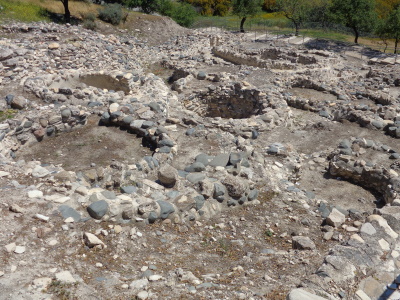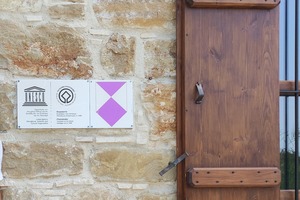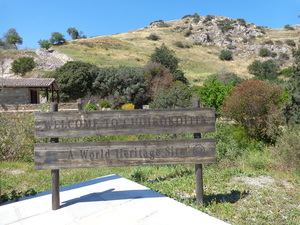Choirokoitia

Choirokoitia is one of the most important prehistoric archeological sites in the eastern Mediterranean.
This only partially excavated site preserves the remains of a proto-urban settlement. It was founded around 7000 BCE, in the Neolithic, as the result of colonization from the Near East. The settlement consisted of circular houses, with the dead buried under the floors of the houses of their living relatives.
Community Perspective: “a jumble of stones”, but the replica circular huts/houses built next to the archaeological remains and the booklet on sale at the entrance help to better understand the concept.
Map of Choirokoitia
Community Reviews
Nan

Choirokoitia, by virtue of being a Palaeolithic site, doesn’t draw hordes of visitors. Recent efforts by the Cypriots have enhanced the visitor experience with updated amenities like parking, toilets, signs, and new trails. However, during our Easter holiday visit, we found ourselves as the sole explorers.
The site primarily comprises settlement foundations nestled on a hill slope, surrounded by walls that once enclosed a town housing around 500 inhabitants. A small river runs behind the hill.
All the buildings were circular and constructed from layered stones. This architectural style mirrors the Nuraghi structures in Sardinia but stands apart from Çatalhöyük across the sea in Türkiye, where rectangular buildings dominate. The absence of “glue” in Choirokoitia’s construction prevented sharp corners, unlike the use of mud bricks in Çatalhöyük.
Similar to Çatalhöyük, the deceased were interred beneath the buildings. I always wonder what you did about the smell or what would have happened if a kid or a dog dug a little into the mud floor...
Notably, Choirokoitia’s civilization predates pottery, as no pottery remnants have been discovered. Around 7000 BCE, the city flourished, but by 6000 BCE, it was abandoned. Contrary to previous assumptions, the entire island wasn’t deserted during this period.
A fascinating titbit: According to German Wikipedia, Choirokoitia is believed to be the first place outside Africa to import cats — very fitting for the island of cats.
When exploring ancient sites, I always grade on a curve. Considering its age of 9000 years and the primitive methods used in its construction, Choirokoitia remains astonishingly tangible. While it may not match Orkney’s grandeur, it certainly deserves a place on the list of remarkable historical sites.
Getting There
Choirokoitia to this day boasts a well-chosen location, as it remains strategically positioned along the main highway connecting Limassol to Nikosia and Larnaka. Intercity buses running between Limassol and Larnaka make stops here, and there are also occasional buses from Paphos and Nikosia that stop. To plan your visit, check the intercity bus schedule online to confirm stops at Choirokoitia.
Upon arrival, you’ll find the bus stop in front of the Oasis restaurant. You will also find a "bus station" sign across the parking lot. This is incorrect, the busses stop at the restaurant.
From the bus stop, a short walk along the road leads to the archaeological site. While you don't have to worry about the highway (there is a tunnel), you still have to walk along the road. The walk takes less than 10 minutes in total.
We arrived from Paphos via Limassol and returned to Limassol for the afternoon. We nearly missed our return bus at the Oasis restaurant because we waited at the (incorrect) bus stop sign and because the buses came from a different direction than anticipated:
- Buses from Limassol arrive via the tunnel.
- Buses heading to Limassol approach directly from the highway (South).
While You Are There
Cyprus is small. If you arrive by car, you can connect to all sites of the island. Along the highway are some more archaeological sites, e.g., Amathous or Tenta, the latter having been part of the original nomination and considered older.
Clyde

I visited this WHS in February 2016. This is one of the WHS on the list which I'd choose for drone photography to be able to better grasp the OUV and sheer size of the place. The replica circular huts/houses built next to the archaeological remains help to better understand the concept of this Neolithic enclosed village system. Excavations are still under way and several remains are covered my metal sheets and numbered. During my early visit (I was the first soul to arrive at 8am), I noticed that one of the usually locked 'gates' which form part of the metal railings was left open by mistake (there must have been a local archaeological study under way the day before as there were still several tools too). Being extra careful not to damage anything I sneaked in the middle of one of the remains of a circular structure/house (marked as number XX on the map) for this quick photo. It reminded me of a similar adventure I had when I visited Al Ain in the UAE and again I was completely alone. All in all, what is left are mainly ruins and surely don't compare with other sites on the list for tangible OUV. However, with quite a lot of imagination (helped by some reading and the replicas on site), this site surely has an important intangible OUV of one of the oldest enclosed villages ever built.
jill
I visited the site /village in 1970 on an art trip from school (St Johns Episkopi) with our teacher Norman Leiter. We sat and drew the villag, and watched some of the villagers creating pots using a coil construction on a slab of wood roatating it with a foot-a very unusual combinations of methods. We scranbled over the ancient village site -and I have never forgotten the day
caroline harvey
i was amased at how beautifully the stone vessels were crafted ,and the elegance of them,when i saw them in the museum.Then i went to see the village.it was very impressive.These inhabitants were very civilised,and i`m glad that i got a chance to peep into their history.
I feel sad for Androulla perhaps cypriots should have free passes for such places,but having said that i have to pay to go to historic siteshere in the uk.
Peter Burton
As an English tourist I sympthise with the local inhabitants in their loss of free access to this remarkable site. Unfortunately this is the reality of modern life, Stonehenge in England in the 1930s was unfenced and with free access. Choirokitia is a World Heritage site and deserves the worthy setting the entrance area has been given.
Clearly the village was established on the hillside with security in mind as the area currently under excavation has made evident. This is not easy for the visitor to make out until an improved viewpoint becomes possible, although the associated information plaque explains how it worked.
Just beyond the site entrance, the group of reconstructed dwellings with grinding stones for grain and even the example of a human burial within the hut make it easier to understand and interpret what you will see later. As a result, peeking through the windows and doorways, I felt closer to these early inhabitants of Cyprus than I have experienced at other more sanitised sites.
As you climb the hill you pass the circles of stones and the reality of life 7000 years BCE is brought to the fore. The interpretive plaques are informative and unintrusive, and the boardwalk makes access as convenient as reasonably possible.
I look forward to visiting Choirokitia again.
sevens
I would like to say that enjoyed your experiences of Choirokoitia and your life there. I was very touched, very much indeed. Just know with what is happening of the coast of Cprus with the discovery of Eden/Atlantis of your coast will bring great respect to these ancient sites of your forefathers.
With all loving kindness and respect.
sevens
ExpatBrit
I live 15 minutes away from Choirokitia and have visited many times with house guests and friends. I have travelled widely and have visited many places that have become WHSs or should do, in 4 continents. This one, along with the Cyprus Museum which displays many of the artefacts from here, is almost a living exhibition of Neolithic man, how he lived and died, possibly more than any other 9000 year old one that I know. One can wonder about the choice of siting the settlement in a bend of the Maroni river; was it for defence? Probably. The way of life is illustrated by the querns and other artefacts like no other Chalceolithic site and the reproduced huts at the bottom of the hill put a light into one's imagination.
Don't miss this really unique site.
Solivagant

No doubt someone will prove me wrong but most Neolithic WHS sites tend to be “Megalithic” (ie related to the placement of large stones for burial, ceremonial or “cultural” purposes eg Stonehenge/Maltese Temples. Strictly this term is non "period specific" and can be used equally for eg 20th century structures). There are few “Neolithic settlements” – perhaps because many of these were of a construction which left few remains or because the nature of the remains means that there is very little for the untrained eye to see – but this hasn’t stopped many other sites with little to see being inscribed!
Historic Orkney contains both the monumental tombs and stone circles of Orkney AND the dwelling of Scara Brae but, offhand, I can only think of Khirokitia (Choirokoitia or Hirokitia) in Cyprus as consisting solely of a Neolithic “settlement”. (Interestingly the perhaps more internationally famous Catalhoyuk in Turkey isn’t on that country’s Inscribed or Tentative list)
So this apparently “minor” site is in fact very significant and is well worth a visit. It lies just north of the Larnaka–Limassol motorway about half way between them. The booklet on sale at the entrance site is worth having to put some flesh on what at first seems a jumble of stones. After a while a pattern emerges of a significant village of some 60 circular stone huts (probably with wood/mud flat roofs) dating from 7th to 4th millennium BCE. A visit to the (excellent) Cyprus museum in Lefkosia (Nicosia) will help place the site in a wider context of the development of human occupation of Cyprus.
Bjorn Haglund
Sweden, but live in London - 01-May-05 -
I discovered Choirokoitia by pure chance, whilst on holiday. My wife and I had been to the Troodos mountains and Paphos and on the way back to Cape Greco we had to fill up petrol late at night at a station just off the motorway after Limassol. The self service machine swallowed my notes but gave my no petrol. I was cursing the place all the way back past Ayia Napa. But the next day, also our last on the island,when we returned to claim the money back we discovered Choirokoitia just there in the day light. It was amazing to climb into a real stone age village! I remember how steep the hill was and the amazing view back to the Mediterranean sea from the top. I also remember the extremely clever way they had deviced a safe entry system, which meant that absolutely nobody who did not have a right to enter stood a chance to get inside alive. This is a place in a different league if you like historical places as much as I do.
Achilleas Tziazas
I have been to Choirokitia several times as a Cypriot citizen. It is amazing how history still lives in this place. Being there, you can imagine prehistoric people walking around, coming in and out the small houses and living together in their village community. This is why Cyprus is a world heritage site. This is why Cyprus' htory should be protected. Because it represents the first steps of our society.
minas savva
i am a 54 year old man i was born in choirokoitia i left to go to england i was a 16 year old boy.
choirokoitia is a beautiful place i know the archeialogical side very well as a small boy and no money i used to go up the very steep hill where the side is and pick the wild daffodills and go down to the main road to sell the daffodills to the tourist for few pennis. i urge anyone who goes to cyprus to pay a visit to this historic and beautifl place.
i
Androulla Tallis
Khirokitia, Cyprus. - 01-May-05 -
I have visited the site on many occassions and each time the experience has been very moving for me.
Some forty years ago, as a young child, I visited the site with my school from the modern village above the settlement. We were allowed to walk around the site, touch and imagine life there. The wild flowers growing only served to make the hill a part of our heritage. Many years later, I spoke to elderly residents of the present-day village who told of the digging and interest in the site. They state that a number of uttensils had been found by the locals, who finding them in their fields, used them in their evryday life. When the French archaelogists turned up at the village in the 1930's these items were identified and taken away. Most of the villagers were employed in the dig and the old men told of the fun and excitement they had as youngsters, when new pieces of broken utensils were found. Sadly today, the site has been barrakaded and a fee is needed to enter it. It was part of our life, growing up in the village, but now it is another monument for the tourists. What has this taught us? The villagers always knew that people, possibly their ancesters had lived there. The river running next to the hill obviously gives the clue to the settlement. This 'modernisation' of the site has actually taken it away from the local community and basically, has allowed strangers to make money out of it. This is happening constantly, sites are being cleaned-up and fenced off so that tourists can visit in clean, sanitised guided tours.
Maybe I am just a sad old person. But the whole earth is being compartmentalised and examined as another exhibit. Every bit of southern Cyprus seems like this today. A vast museum! Where is the real, live Cyprus where errosion and evolution continue?
Els Slots
With some of these very ancient sites, your mind has to work hard to transform a bunch of stones into the great place it once was. This could also have been the case with 9000(!) year old Choirokoitia, but here they decided to rebuild a group of houses in the original style, just outside the archeological finding place.
From this, you learn that the inhabitants of the village lived in round, African-style huts. A few of them together formed an entity and shared the same courtyard. With this picture in mind, you walk up to the main part of the site and recognize easily the round clusters of stones that used to be the houses of the ancient Choirokoitians.
Community Rating
- : Orphanos Thomas Harold Watson WalGra
- : Rodinia
- : Hanming Cezar Grozavu Luki501 George Gdanski Rvieira Fede1203 Tarquinio_Superbo
- : Travelure Christravelblog Argo Thibault Magnien Kevin McFarland
- : Alexander Barabanov Juropa Aspasia Philipp Peterer Mikko Walter Pierre T MaxHeAnouBen David Berlanda CeeMon Roman Raab ChrisN Yevhen Ivanovych Randi Thomsen Bill Maurmann
- : Cmtcosta Nan Lucio Gorla Aslak Riccardo Quaranta Carlos Sotelo Frederik Dawson Peter Lööv Solivagant Szucs Tamas Adrian Turtschi Kristin Svein Elias Martina Rúčková Luboang Aljaz
- : Alexander Lehmann Els Slots Ivan Rucek NonDuality Squiffy Purrfect Joyce van Soest Christoph Max
- : John Smaranda Clyde Gary Arndt Philipp Leu Dirk-pieter Lukasz Palczewski
- : Zoë Sheng Wojciech Fedoruk Lukasz N. KentishTownRocks GZ Dorejd Little Lauren Travels
- : Hurrvinek
Site Info
- Full Name
- Choirokoitia
- Unesco ID
- 848
- Country
- Cyprus
- Inscribed
- 1998
- Type
- Cultural
- Criteria
-
2 3 4
- Categories
- Archaeological site - Prehistoric
- Link
- By ID
Site History
1998 Revision
Has been part of the former TWHS The Cyprus Prehistoric Sites: Khirokitia, Tenta, Ayios Dhimitrios at Kalavassos (1984)
1998 Inscribed
Site Links
Unesco Website
Official Website
Related
Connections
The site has 9 connections
Constructions
History
Human Activity
Science and Technology
Timeline
World Heritage Process
Visitors
204 Community Members have visited.
The Plaque
 (photo by Riccardo Quaranta)
(photo by Riccardo Quaranta) (photo by Argo)
(photo by Argo)